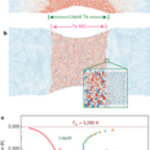Chemistry

Chemicals known as hormone mimics may damage our ability to reproduce and pollute the natural environment. Now there may be a new way of capturing them.
In a laboratory in Trondheim, researchers have managed to create minute particles with some very desirable properties, such as the ability to capture and break down any hormone mimics that have ended up in our waste water. These unwanted chemicals come from the kind of consumer items that make our lives easier and more comfortable. But they have consequences.
"We know that hormone mimics are harmful to us, and that they don’t break down…

A catalyst made from a foamy form of copper has vastly different electrochemical properties from catalysts made with smooth copper in reactions involving carbon dioxide, a new study shows. The research suggests that copper foams could provide a new way of converting excess CO2 into useful industrial chemicals.
As levels of carbon dioxide in the atmosphere continue to rise, researchers are looking for ways to make use of it. One approach is to capture CO2 emitted from power plants and other facilities and use it as a carbon source to make industrial chemicals, most of which are currently made…

Injuries, birth defects and sometimes surgery to remove a tumor can create gaps in bone that are too large to heal naturally, and in the head, face or jaw, they can dramatically alter a person's appearance.
At the National Meeting&Exposition of the American Chemical Society, researchers presented details about a "self-fitting" material that expands with warm salt water to precisely fill bone defects, and also acts as a scaffold for new bone growth.
Currently, the most common method for filling bone defects in the head, face or jaw (known as the cranio-maxillofacial area) is autografting…

As countries try to rid themselves of toxic mercury pollution, some people are still slathering and even injecting creams containing the metal onto or under their skin to lighten it, putting themselves and others at risk for serious health problems.
The good news is, researchers can now identify these creams and intervene much faster than before using total reflection x-ray fluorescence.
Just don't buy this junk. The science is settled.
"In the U.S., the limit on mercury in products is 1 part per million," says Gordon Vrdoljak, Ph.D., of the California Department of Public Health, who…

Materials scientists have long sought to form glass from pure, monoatomic metals and Scott X. Mao, a Professor of Mechanical Engineering and Materials Science at the University of Pittsburgh, and colleagues have done it.
How was it accomplished? It's long been conjectured that any metallic liquid can be vitrified into a glassy state provided that the cooling rate is sufficiently high. As is said about the original alchemy, turning lead into gold, it is now simply a matter of having enough energy. But this of vitrification single-element metallic liquids has needed more than just high…

Natural gas proliferation has been a huge boon for the environment - CO2 emissions have plummeted among the U.S. energy sector, primarily because coal emissions have been knocked back to early 1980s levels. But there are concerns by environmentalists that modern hydraulic fracturing ("fracking") has risks, and it has been implicated in everything from earthquakes to methane in water even to claims it will cause the earth to deflate.
Chemists think about chemicals and at a presentation at the 248th National Meeting&Exposition of the American Chemical Society (ACS), William Stringfellow, Ph…

For burn victims, guarding wounds against infection is critical but wrapping wound dressings around fingers and toes can be tricky. Scientists have reporting the development of novel, ultrathin coatings - nanosheets - that can cling to the body's most difficult-to-protect contours and keep bacteria at bay.
Yosuke Okamura, Ph.D., explains that existing wound dressings work well when it comes to treating burns on relatively flat and broad areas. But the human body has curves, wrinkles and ridges that present problems for these dressings. So Okamura's team developed a novel biomaterial out…

Alcohol, including red wine which has acquired its own modern health food mythology, may be damaging to your health in a way you hadn't thought about before.
It isn't just the booze itself, a group of scholars contends it's the packaging. Phthalate compounds are widespread in our environment and present in many plastics. Obviously, any toxicity of phthalates varies depending on their chemical composition and some compounds are considered to be potential hormone disruptorrs, so they are regulated on an international level, including for those likely to come into contact with food and drink…

A new strategy enables molecules to be disconnected essentially anywhere, even remote from functionality.
The organic synthesis strategy, developed by Professor Varinder Aggarwal and Dr Ramesh Rasappan in the School of Chemistry, involves a new method for combining smaller fragments together in which there is no obvious history in the product of their genesis.
Their paper describes not only this new strategy, but also its application to the shortest known synthesis, just 14 steps, of hydroxyphthioceranic acid, a key component of the cell wall lipid of the virulent mycobacterium…

Highly purified crystals that split light with uncanny precision are key parts of high-powered lenses, specialized optics and, potentially, computers that manipulate light instead of electricity. Producing these crystals often involves etching them with a precise beam of electrons and can be difficult and expensive.
Researchers at Princeton and Columbia universities have proposed a new method that could allow scientists to customize and grow these specialized materials, known as photonic crystals, with relative ease.
In their article, the researchers proposed that photonic crystals…